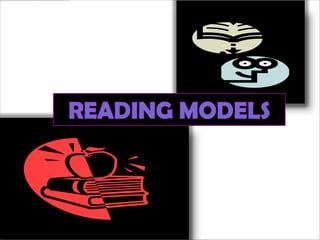Melden
Teilen

Empfohlen
Empfohlen
Weitere ähnliche Inhalte
Was ist angesagt?
Was ist angesagt? (20)
Andere mochten auch
Andere mochten auch (16)
Ähnlich wie Reading models
Ähnlich wie Reading models (20)
Practicas Discursivas de la Comunicación Escrita 4

Practicas Discursivas de la Comunicación Escrita 4
Teachers' Beliefs and Attitudes towards Teaching Reading Comprehension to EFL...

Teachers' Beliefs and Attitudes towards Teaching Reading Comprehension to EFL...
Mehr von Jesullyna Manuel
Mehr von Jesullyna Manuel (20)
Curriculum development in language teaching handdouts

Curriculum development in language teaching handdouts
Analysis of the word pinch in shakespeare's the tempest

Analysis of the word pinch in shakespeare's the tempest
Chapter 1 principles and theories in curriculum development

Chapter 1 principles and theories in curriculum development
Reading models
- 3. It is a reading model that emphasizes the written or printed text. It emphasizes the ability to decode or put into sound what is seen in the text. Readers derive meaning in a linear manner.
- 5. It is a model in which TOP is the higher order mental and BOTTOM as the physical text on the page. It is where meaning takes precedence over structure.
- 7. Combination of Bottom-up and Top-down processes. Good readers are both good decoders and good interpreters of the text.
- 9. RUMELHART MODEL (1977)
- 10. States that successful reading is both a PERCEPTUAL and a COGNITIVE process. - Orthographic knowledge - Lexical, Syntactic and Semantic knowledge
- 11. STANOVICH MODEL (1980)
- 12. Interactive-compensatory reading model. Readers who rely on both Bottom-up and Top-down processes are depending on: - reading purpose - motivation - schema - knowledge of the subject
- 13. ANDERSON and PEARSON SCHEMA- THEORETIC VIEW
- 14. It focuses on the role of schemata (knowledge stored in memory) in text comprehension. SCHEMA THEORY a. relationships among components b. role of inference c. reliance on knowledge of the content
- 15. PEARSON and TIERNEY R/W MODEL
- 16. Considers PRAGMATIC THEORIES which state that: “utterance is an action”. CONTEXT is important. INTERACTIVE ROLES: - Planner - Composer - Editor - Monitor
- 17. MATHEWSON’S MODEL OF ATTITUDE INFLUENCE
- 18. Attitude toward reading may be modified by a change in reader’s goal. Attitude has tri-componential construct: - cognitive component - affective component - conative component
- 19. Maintains that feedback may affect attitude and motivation during the reading process. 1. Satisfaction with affect developed through reading. 2. Satisfaction with ideas developed through reading. 3. Feeling generated during the reading process. 4. Ideas constructed from the information read. 5. How the reading affects the values, goals, and self-concepts.
